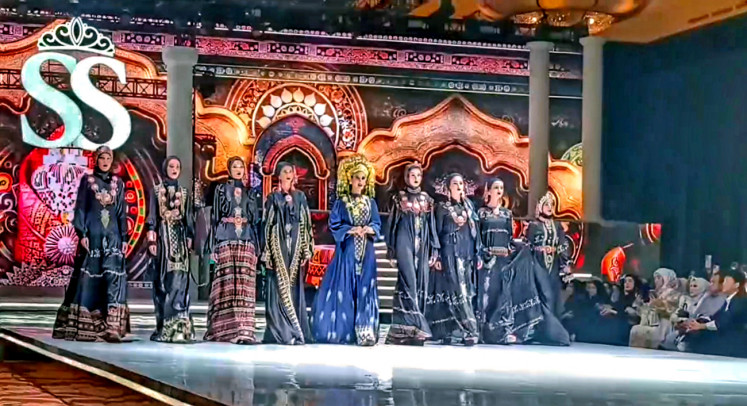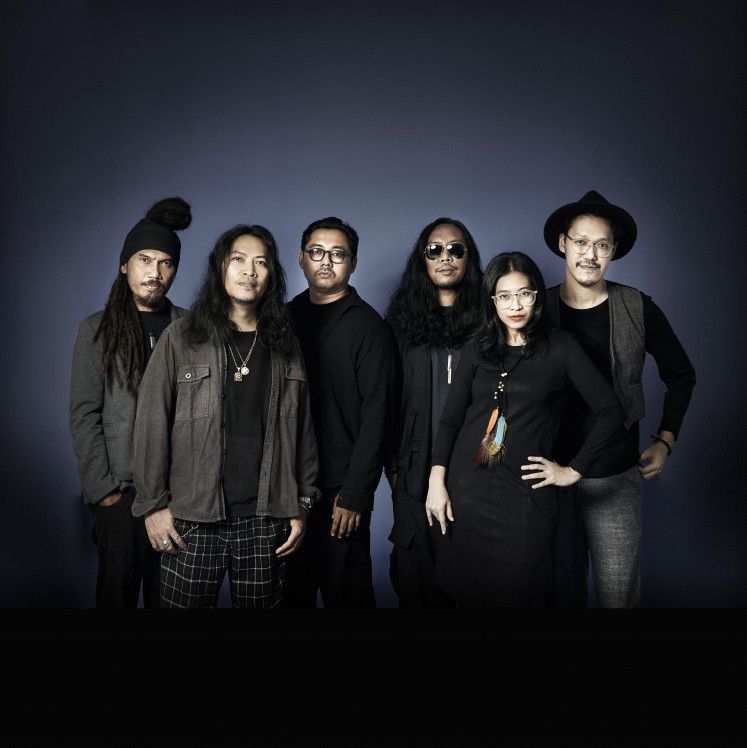Afghan artist's 'Iron Cocoon' lights up Jogja Art Week
Decapitated Buddha statues are an on-going theme throughout Iron Cocoon, in which Amin Taasha makes reference to the Taliban’s destruction of the monumental Buddhist statues in his homeland.
Change Size
 'Iron Cocoon' by Amin Taasha (JP/Richard Horstman)
'Iron Cocoon' by Amin Taasha (JP/Richard Horstman)
I
ndonesian and international art audiences visiting Yogyakarta during Jogja Art Week (JAW) have a unique opportunity to observe a new direction in Asian art.
Iron Cocoon is the second solo exhibition by emerging Afghan artist Amin Taasha. It runs until June 7 at Galeri Fadjar Sidik on the Indonesian Arts Institute (ISI) campus, Yogyakarta, as part of JAW, a month-long program of art events held throughout Central Java.
The exhibition features a collection of “Abstract-Miniaturism” paintings, presented together with audio compositions by Serbian composer Vanja Dabic and text, video and installation art, which may be observed individually, or as a whole.
Taasha’s compositions are a unique fusion of Asian cultural influences alongside post-contemporary art ideals, featuring ancient Persian script, Buddhist iconography and figures referencing 7th to 11th century Afghan miniature paintings; which join forces with Chinese ink-styled modified strokes. Born in 1995 in Bamiyan Province, the mountainous central region of Afghanistan, Taasha draws upon a wealth of traditional Central Asian art, with elements of Greek and Buddhist art that are merged into a distinctive classical style known as Greco-Buddhist, which he transforms through the use of abstraction.
Read also: Huang Fong: Painting heaven on Earth
Decapitated Buddha statues are an on-going theme throughout Iron Cocoon, in which Taasha makes reference to the Taliban’s destruction of the monumental Buddhist statues in his homeland. While the painting Forbidden, one of 10 larger vertical and horizontal monochromatic scenarios, makes direct reference to the atrocity committed by the Taliban, it is his central and culminating installation, Witness, which delivers the graphic evidence and impact of the events that shocked the world in 2001.
A circular line of the Earth becomes the frame for a short video documentary compilation that reveals Taliban tanks and rockets firing at the giant icons over a four-day period, until they finally forced local people to lay explosives inside the statues. In response to this, cultural experts lamented the demise of these iconic monuments. At the edge of the video projection, a seated Buddha statue grounds the installation, ironically as a headless observer, while suspended and floating above, its decapitated head is taken away by a black crow in flight. Iron Cocoon is rich in symbolic metaphors, with some of the crows throughout the exhibition representing the powerful ignorant few that destroy important history and culture, while other crows are presented in stark contrast, as the saviors of heritage and understanding.
Within Taasha’s paintings, his mastery comes alive through his language of aesthetic simplicity. He balances the visual worlds of color and form into perfect unions of the abstract, combined delicately with recognizable forms. He communicates on both the conscious and subconscious levels through his Zen code of symbolic metaphors, and especially with his use of animals. His tiny figures at once connect us with an ancient past and present that convey timeless wisdom.
Read also: ARTJOG attracts renowned international collectors
Black is the predominant visual feature. Its enigmatic potency functions on the subconscious level, creating a metaphysical realm with which to engage the audience. This blackness conjures up what Buddhists refer to as “the void” -- a place of commanding inner peace. Fine splashes of ink appear like smoke, and represent the eternal cycle of life. Gold and silver leafing are another important aesthetic feature, along with a measured array of dynamic colors, they function as powerful aesthetic tools, contrasting against the black.
The Iron Cocoon catalog states, “The concept of Taasha’s exhibition takes the metaphor of an armored cocoon; a flexible protected shell that allows the person within to be able to transform, safe from conflicts occurring outside. This is partially in reference to Taasha growing up in Afghanistan, a country synonymous with death and violence, and how art is able to first germinate in this environment, before being transposed to another country, where it can begin to grow in its new style.”
The artist and his collaborators’ attention to detail and high levels of presentation transform the gallery, making it memorable, where a mysterious ambiance prevails. Taasha’s sensitivity connects with the deepest level of our psyche, touching the soul. Works of extraordinary precision -- beautiful and serene -- Iron Cocoon reflects a maturity that belies the artist’s years.
Taasha moved to Kabul when the Taliban took over the Bamiyan area and began studying art in 2007, in 2010 he attended the Kabul Fine Arts Institute where he studied painting, miniature painting and calligraphy. In 2012, he was invited to participate in a workshop, Seeking Study, at the National Gallery of Afghanistan, as a part of the Documenta 13 international art project in Kabul. Two of his works were mistakenly deemed to contain controversial subject matter and were prohibited from the exhibition by the Afghan Ministry of Information and Culture. Taasha was later subjected to police interrogation with the barrel of an AK-47 being pressed against his head and threatened with death.
In 2013, he moved to Central Java after receiving a one-year scholarship to study at UNNES Semarang, and in 2014 he attained a four-year scholarship to study art at ISI Yogyakarta, where he has been ever since. He has exhibited consistently for the past 10 years in Afghanistan and Indonesia, as well as in Iran, Bangladesh, Lebanon, Indonesia, the United States, Canada, Germany and Italy. His works are in collections in the United Kingdom, the US, Canada, the Netherlands, Germany, France, India, Australia, Singapore and Indonesia. Iron Cocoon is his first solo exhibition in Indonesia.
Taasha, who exhibited in The Death of Contemporary Art, a three-artist group exhibition at the studio complex of leading Indonesian artist Heri Dono in 2016 in Yogyakarta, is part of a group of post-contemporary artists. Iron Cocoon follows on from him taking part in two major exhibitions in Bangladesh and Iran this year, in which all of his works were sold. (kes)
__________
Iron Cocoon
Date: Open Monday-Friday until June 7
Place: Galeri Fadar Sidik, ISI Yogyakarta, Jl. Parangritis, Sewon, Bantul, Yogyakarta









